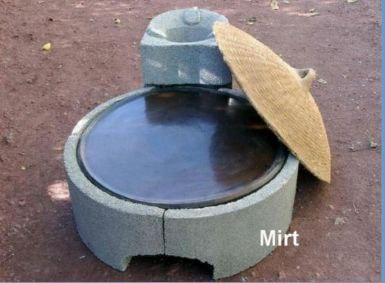In Ethiopia baking specially injera (cultural food of most Ethiopians) is energy intensive activity which leads extraction of enormous biomass resources. This condition would be continuing in the future. This abundant biomass resource utilization with land use change together causes severe biological resource depletion, to minimize forest depletion, Mirt injera stove was developed by Ministry of Water and Energy (former Mistry of Mine and Energy). According the Ministry, several control cooking tests revealed a fuel saving of about 50% and kitchen carbon monoxide (CO) concentration reductions of about 90% compared with three-stone open fire. This improved stove for baking used as alternative of traditional baking stove (open fire stove) which causes extreme deforestation while Mirt stove reduces the need for biomass fuel and cooking time even when biomass use cannot be, avoided. Moreover, Mirt stove could relieve rural households of the difficulty of gathering fuel from long distance which bother rural women.
"Mirt " improved cooking stove

Biomass energy is the most important energy source for Ethiopia which is above 90%. Ethiopian rural households are dependent on two main solid fuels (woody biomass and dung) for centuries. These fuels are typically burned in traditional stoves. As a result, these types of stoves produce higher air pollution, which results in an increased risk of acute respiratory infection and lung diseases, especially for women and young children. On the other hand, the utilization of solid biomass fuel is increasing from time to time with the population growth. Due to the overutilization of biomass, the sustainability of Ethiopian biomass supply is questionable. Work pressure and walking long distance to collect biomass especially for women is also a problem. It also reduce the problem of biomass utilization by the community in the Shashemene zuria Woreda.
‘Mirt’ means ‘best’ in Amharic, and these eco-stoves are used for baking Injera, a pancake like thin bread made of teff flour, and is also used to cook and boil food while baking without the use of additional fuel. Mirt is produced with mortar – a mixture of river sand with cement and has an average lifespan of five years. A series of control cooking tests revealed a fuel saving of about 50% and kitchen carbon monoxide (CO) concentration reductions of about 90% compared with three-stone open fire. Results from laboratory tests conducted by the Ethiopian Rural Energy Development & Promotional Centre showed a range of 18 - 23 percentage heat utilization. Based on the assessment of Motion training and consultancy PLC, Mirt stove is more affordable to vulnerable groups, accessible to all social groups, acceptable by the community, effective, efficient, scalable, and replicable compared to the other identified technologies. All the above makes it unique for selling. Licensed associations are producing the stove, and it is led by women and young and disabled people are member of association.
The overall problems that this alternative case has contributed to communities by reducing work pressure especially for women. The hygiene and health of women is protected by reducing smoke. It has reduced deforestation and reduced indoor air pollution and reduced risk of fire. It is clean, easy to maintain and cooks faster. The number of Mirt stoves produced and distributed to beneficiaries is 7729.
Non-governmental organizations are providing training and financial support whereas the government is playing promotion role. Concerning technical resources and the capacity available, although not enough, there is provision of materials like mold. The producers have equib and bank accounts to save their profit so that it is economically feasible. There are legal frameworks like Ethiopian national adaptation plan and Climate Resilience Green Economy etc.
Mirt cooking stove has improved the wellbeing of households and the environment, and reduced fuel wood consumption and indoor smoke. ActionAid Ethiopia has also promoted energy saving cooking stoves in many Woredas, including Ameya (Oromia region) and Guna (Amhara region), benefiting more than one thousand of women. ActionAid has also supported the establishment of a cooking stove producer cooperative with the goal of providing members with a source of income and increasing access to energy-saving stoves for women and the community, which has a direct impact on health, the economy, and the environment. Women have stated the benefits they derive from improved cooking stoves, which save them time, money, and improve their health.
Commercial fuels like electricity and gas are inaccessible, too expensive or too irregularly supplied to use for cooking and heating. On the other hand, although biomass fuels often self-collected and easy to use in inexpensive traditional stoves, this leads to severe public health problems, especially for women and children exposed to indoor smoke, and also can lead to forest degradation and biomass purchase expense. Thus, if there is transport to market place, market linkage, and financial support the technology has high potential for scaling up.
Smallholder farmers have limited financial and technical capacities, thus the expansion of technology requires financial and technical support from government organizations and non-governmental organizations (NGOs and GOs), as indicted by the key informant interview.
A lot of Mirt stoves are produced and stored due to lack of market linkage. Thus, Market linkage should be facilitated.

